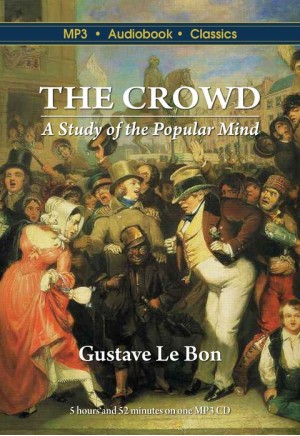| Track | Section | Length |
| 1 | 00 - Preface The Crowd: A Study of the Popular Mind | 8:29 |
| 2 | 01 - Introduction The Era of Crowds | 16:04 |
| 3 | 02 - Book 1 Chapter 1 - General Characteristics of Crowds--Psychological Law of Their Mental Unity | 20:25 |
| 4 | 03 - Book 1 Chapter 2 - The Sentiments and Morality of Crowds | 44:41 |
| 5 | 04 - Book 1 Chapter 3 - The Ideas Reasoning Power and Imagination of Crowds | 20:17 |
| 6 | 05 - Book 1 Chapter 4 - A Religious Shape Assumed by all the Convictions of Crowds | 11:12 |
| 7 | 06 - Book 2 Chapter 1 - Remote Factors of the Opinions and Beliefs of Crowds | 41:09 |
| 8 | 07 - Book 2 Chapter 2 - The Immediate Factors of the Opinions of Crowds | 27:46 |
| 9 | 08 - Book 2 Chapter 3 - The Leaders of Crowds and their Means of Persuasion | 42:26 |
| 10 | 09 - Book 2 Chapter 4 - Limitations of the Variability of the Beliefs and Opinions of Crowds | 23:58 |
| 11 | 10 - Book 3 Chapter 1 - The Classification of Crowds | 7:47 |
| 12 | 11 - Book 3 Chapter 2 - Crowds Termed Criminal Crowds | 9:14 |
| 13 | 12 - Book 3 Chapter 3 - Criminal Juries | 16:00 |
| 14 | 13 - Book 3 Chapter 4 - Electoral Crowds | 19:22 |
| 15 | 14 - Book 3 Chapter 5 - Parliamentary Assemblies | 42:46 |
Production
Book Coordinator: Oxenhandler
Meta Coordinator: Annise
Proof Listener: DaveC
Artwork
Cover:The Crowd, 1875, by Robert William Buss
Inset: Picture of Gustave Le Bon, 1888, Truchelut
Inset: Title page of Psychologie des foules, by Gustave Le Bon, 1895
Insert: Sea port with the lecture of Christ , between1600-1625, Jan Brueghel the Elder
Label: Distribution of Loaves to the Poor, 1st half 17th century, David Vinckboons
The Crowd: A Study of the Popular Mind, written by Gustave Le Bon and published in 1895, is considered a seminal work in the field of crowd psychology. While it was not the first work on the subject, it was the first to propose that a crowd is itself a distinct entity that emerges from an assemblage of persons that possesses a “collective unconsciousness” and a “magnetic influence” that changes the behavior of it constituents until it becomes governed by a “group mind”. This influence robs each of its individual members of their opinions, values and beliefs in the process. Le Bon states: "An individual in a crowd is a grain of sand amid other grains of sand, which the wind stirs up at will". Le Bon posits three key processes at play: anonymity, contagion, and suggestibility. Anonymity imparts a sense of invincibility and a loss of personal responsibility that causes a devolution of the individual to the primitive, emotional, and unreasoning instinctual drives.Contagion enables the rapid spread of ideas and behaviors in the group and the sacrifice of personal interests to the collective interest. Suggestibility is the mechanism of the contagion, used by the strong voices to impart ideas that guide the contagion of behavior. Such leaders Le Bon describes as “usually men of action rather than of words. They are not gifted with keen foresight... They are especially recruited from the ranks of those morbidly nervous excitable half-deranged persons who are bordering on madness." The book became an instant bestseller upon publication and was translated in nineteen languages within a year. Its message is especially intriguing today in light of the phenomena observed in virtual groups that emerge on social media.
Play sample:
Download a PDF datasheet
| Item Info | |
| EAN - DVD case | 0701236969481 |
| EAN - CD jacket | 0686175923407 |
| Media | MP3 CD |
| Package | DVD Case |
| Author | Gustave Le Bon (1841 - 1931) |
| Recording | |
| Read by | Oxenhandler |
| Length | 5 hours and 52 minutes |
| Type of Reading | Solo reading |
The Crowd: A Study of the Popular Mind
- Author: Gustave Le Bon
- Product Code: DB-1229
- Availability: In Stock
-
$9.99
Available Options
Related Products
A Discourse Upon the Origin and the Foundation of the Inequality Among Mankind
Jean-Jacques Rousseau wrote A Discourse Upon the Origin and the Foundations of Inequality Among Men ..
$9.99








